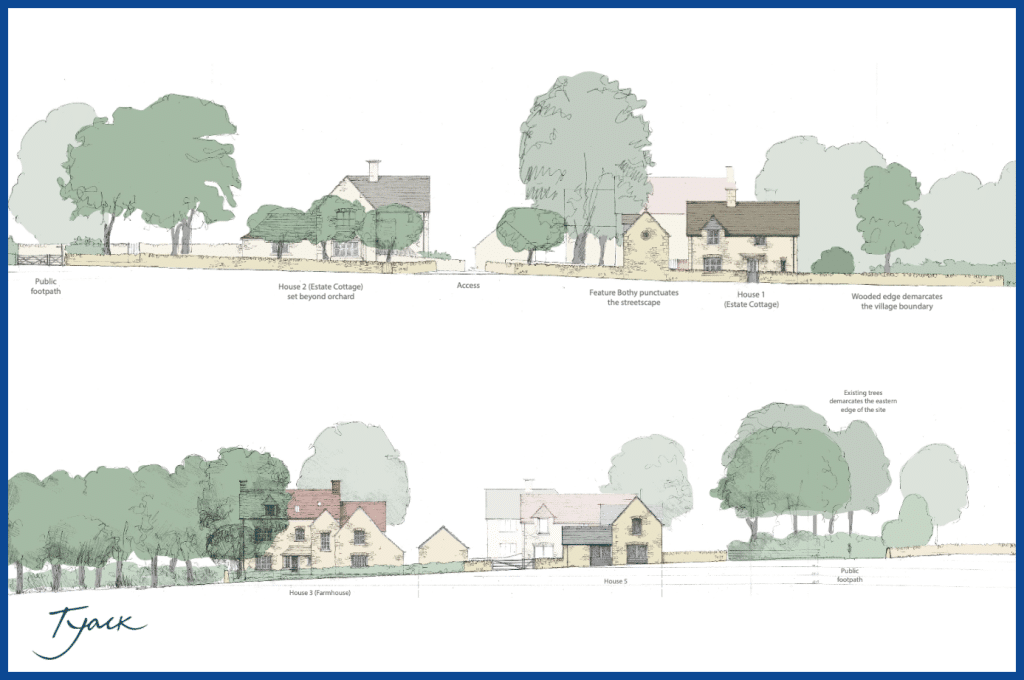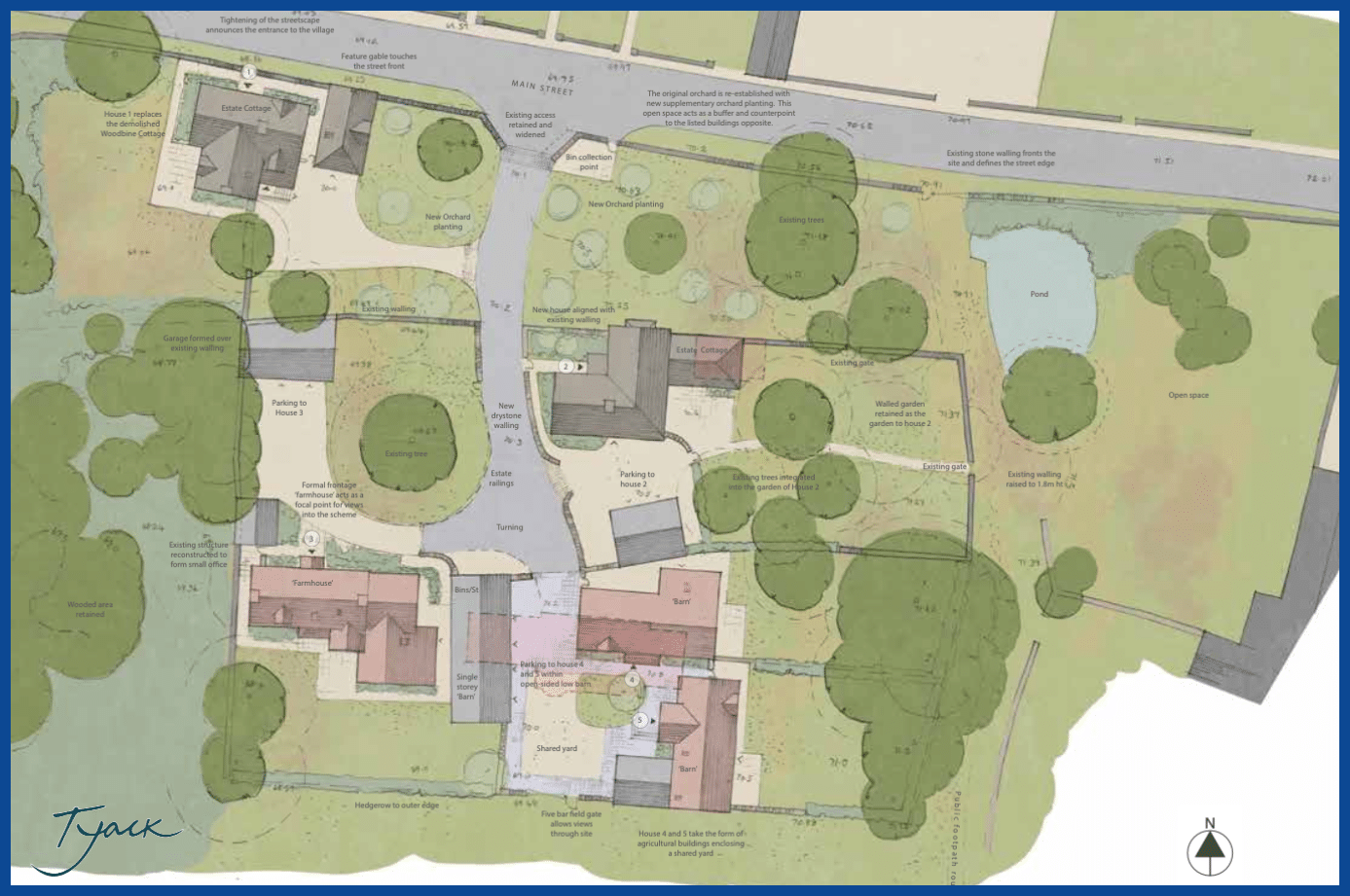Planning approved for 5x new homes outside the settlement boundary in Wychavon
We are absolutely delighted to have secured planning approval for the demolition of an existing dwelling and its replacement with 5x 3, 4 and 5 bed detached homes and associated amenity space, including a community orchard. This project will regenerate an unsightly and dilapidated plot and bring much-needed family homes to the area.
Developments in open countryside
On the face of it, a challenging project. The site is situated outside the settlement boundary, in open countryside, in the Cotswolds National Landscape (AONB), in close proximity to several Grade II Listed buildings and in a Conservation Area. But as the Council cannot currently demonstrate a five-year housing land supply (2.78 year supply as of April 2024), the ‘tilted balance’ is engaged. This means that planning permission should be granted unless any adverse impacts of doing so would significantly and demonstrably outweigh the benefits.
Weighing up the planning balance on a challenging development plot
Given the sensitivities on site, our team engaged in a dialogue with the Council about the site and proposals early on with a pre-application meeting. This fed into the final design and the associated planning application where we and the wider project team successfully highlighted the nuances of the project and the wider benefits it would bring.
These included:
Housing need: The proposal would provide a net increase of 4 dwellings which would contribute positively towards the council’s housing supply deficit and respond to an identified need for this type of housing.
Economic benefits: There would be a short-term benefit to the rural economy during the construction period.
Landscape impact: The Council agreed that the proposals would greatly improve the visual impact of the site within the National Landscape areas and that the scheme’s sensitive design responded well to the wider context of the site, both current and historic.
Open countryside: Whilst local policy strictly controls development in this type of location, as the scheme sought to demolish an existing dwelling, a precedent for housing had been established. Furthermore, the site had been allocated for new housing in the local plan.
Outside the development boundary: The site sits on the edge of a village settlement and despite its technically ‘rural’ location, it benefits from proximity to a good bus service and is within safe walking distance of local amenities.
Effective use of land: Not only do the proposals present an effective use of brownfield land, but given the sensitive nature of the site, a lower housing density was proposed to allow for its proximity to listed buildings and existing boundary treatments, including several established trees.
Green Infrastructure: The lower housing density on site meant that the proposals were able to far exceed the 20% requirement for the provision of Green Infrastructure, which includes a large orchard.
Conservation area: The proposal involves the replacement of the existing dwelling on the site with a development of five detached ‘estate’ type cottages, designed to emulate the character of the surrounding area. The Conservation Officer agreed that the design was well-conceived and that the introduction of the orchard would help to restore the historic appearance of agricultural land across the area.
Residential amenity: It was felt that the proposals would have minimal impact on residential amenity and would not result in issues of highway safety.
Archaeology: The site has the potential to be archaeologically sensitive. Given the scale of the development and the anticipated archaeological potential, we successfully established that any archaeological concerns could be successfully mitigated via condition and with an appropriate action plan in place.
Making the case for new homes in a sustainable location
The council agreed that the benefits of allowing the proposed development would outweigh the harm that may otherwise be caused by allowing residential development in the open countryside. We are so pleased that this site can now realise its full potential, replacing a dilapidated building with 5x beautiful family homes and an orchard, improving the views across the AONB and bringing much-needed housing to the area.
How our planning consultants can help your development project
This project is a prime example of the crucial role planning consultants play in giving a development proposal its best chance of success. Application decisions are all a matter of planning balance – balancing the harm against the benefits with reference to adopted policy. Our role is to tease out the benefits of your proposal, ensure the necessary technical supporting reports and plans are provided and to present the proposal holistically to the LPA, setting out why it should be granted permission in the round. We work hard to establish contact with planning officers and build relationships, rather than taking an adversarial approach, which can often do more harm than good.
About us
We are McLoughlin Planning and our team have a simple objective: to get results for our clients by providing high quality planning consultancy.
Our reputation for integrity, innovation and intelligence means we are a growing business, thriving on personal recommendations from our loyal clients and trusted industry colleagues. Our team of chartered town planning consultants deal with a host of interesting planning projects from across southern England and Wales – from strategic promotions and commercial premises to private developments and rural projects.
We are a friendly and approachable team who care passionately about the built environment, always striving to get the best outcome for our clients and the community
Contact us to see how we can best assist you with your development aspirations.
Key contact for this project
Chris Fleming – Director
E: chris.fleming@mplanning.co.uk
T: 01242895008
Project team
- Portus and Whitton (Landscape Architects)
- Tyack Architects Ltd (Architects)
- Rappor (Drainage)
- EDP (Heritage, Arboriculture, Ecology and Archaeology)
Image source: Tyack Architects (2024)

